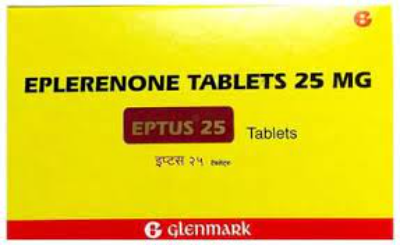


Cardiac failure secondary to recent M.I.: adjunctive treatment
Chronic cardiac failure (NYHA Class II) with LVEF <31% : adjunct
For addition to standard therapy (including beta-blockers), to reduce to risk of cardiovascular mortality and morbidity in stable patients with left ventricular dysfunction (LVEF equal to or less than 40%) and clinical evidence of heart failure after recent myocardial infarction.
For addition to standard optimal therapy, to reduce the risk of cardiovascular mortality and morbidity in adult patients with New York Heart Association (NYHA) class II (chronic) heart failure and left ventricular systolic dysfunction (LVEF less than or equal to 30%).
Patients with a serum potassium level of greater than 5 mmol/L should not be started on eplerenone. Measure serum potassium prior to therapy, within the first week and at one month after start of treatment or dose adjustment. Assess serum potassium periodically thereafter.
Once initiated, dosage should be based on the serum potassium level.
The Renal Drug Handbook suggests the following doses for renal impairment:
Baseline serum potassium above 5 mmol/L
Children under 18 years
Breastfeeding
Galactosaemia
Renal impairment - eGFR below 30ml/minute/1.73m sq
Severe hepatic impairment
Elderly
Diabetes mellitus
Glucose-galactose malabsorption syndrome
Lactose intolerance
Mild hepatic impairment
Pregnancy
Renal impairment
Advise ability to drive/operate machinery may be affected by side effects
Contains lactose
Monitor serum potassium levels before treatment
Consider dose reduction if significant rise in serum potassium occurs
Monitor serum potassium regularly
Increased risk of hyperkalaemia with K+ suppl. and K+ sparing diuretic
Advise patient not to take NSAIDs unless advised by clinician
Advise patient not to take St John's wort concurrently
Advise on problems of salt substitutes/high intake of potassium-rich food
Advise patient grapefruit products may increase plasma level
Hyperkalaemia may occur. Monitor potassium levels in all patients at initiation of therapy, within the first week and at one month after the start of treatment or dose adjustment.
One study suggested that the concurrent use of hydrochlorothiazide may offset increases in serum potassium.
Eplerenone is not dialysable.
Monitor serum electrolytes in patients with hepatic impairment.
Use eplerenone with caution in pregnancy.
Caution when prescribing eplerenone to pregnant women as there is no adequate data.
Animal studies did not indicate direct or indirect adverse effects with respect to pregnancy, embryofoetal development, parturition and post natal development.
The use of all medication in pregnancy should be avoided whenever possible
Eplerenone is contraindicated in breastfeeding.
It is unknown if eplerenone is excreted in breast milk.
Because of the unknown potential for adverse effects on the breastfed infant, a decision should be made whether to discontinue the drug or discontinue breastfeeding taking into account the importance of the drug to the mother.
Angioedema
Arterial thrombosis
Asthenia
Atrial fibrillation
Azotaemia
Back pain
Blood urea increased
Cholecystitis
Constipation
Cough
Dehydration
Diarrhoea
Dizziness
Elevated blood glucose (transient)
Eosinophilia
Epidermal growth factor receptor decreased
Flatulence
Gynaecomastia
Headache
Hypercholesterolaemia
Hyperhidrosis
Hyperkalaemia
Hypertriglyceridaemia
Hypoaesthesia
Hyponatraemia
Hypotension
Hypothyroidism
Increase in creatinine
Infections
Insomnia
Left ventricular failure
Leg cramps
Malaise
Muscle spasm
Musculoskeletal pain
Myocardial infarction
Nausea
Pharyngitis
Postural hypotension
Pruritus
Pyelonephritis
Rash
Renal impairment
Syncope
Tachycardia
Vomiting